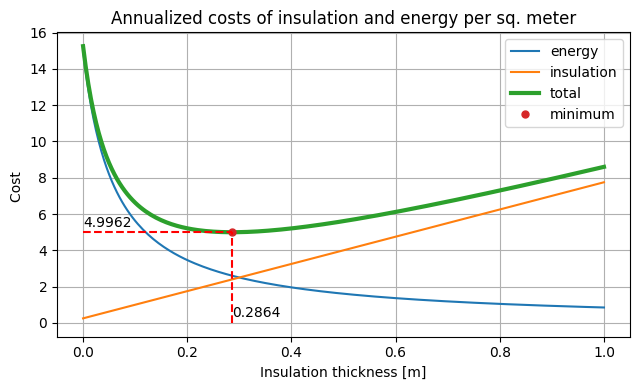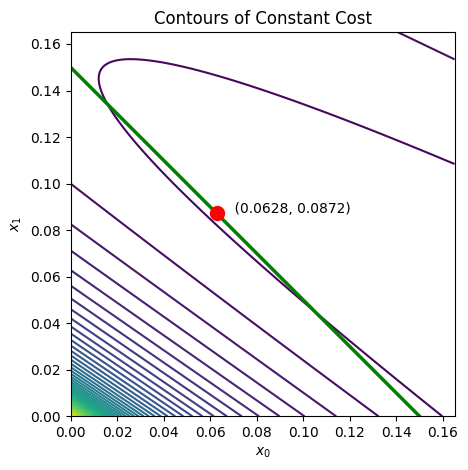6.4 Optimal Design of Multilayered Building Insulation#
Thermal insulation is installed in buildings to reduce annual energy costs. However, the installation costs money, so the decision of how much insulation to install is a trade-off between the annualized capital costs of insulation and the annual operating costs for heating and air conditioning. This notebook shows the formulation and solution of an optimization problem using conic optimization.
Preamble: Install Pyomo and a solver#
This cell selects and verifies a global SOLVER for the notebook.
If run on Google Colab, the cell installs Pyomo and ipopt, then sets SOLVER to use the ipopt solver. If run elsewhere, it assumes Pyomo and the Mosek solver have been previously installed and sets SOLVER to use the Mosek solver via the Pyomo SolverFactory. It then verifies that SOLVER is available.
import sys, os
if 'google.colab' in sys.modules:
%pip install idaes-pse --pre >/dev/null 2>/dev/null
!idaes get-extensions --to ./bin
os.environ['PATH'] += ':bin'
solver = "ipopt"
else:
solver = "mosek_direct"
import pyomo.kernel as pmo
SOLVER = pmo.SolverFactory(solver)
assert SOLVER.available(), f"Solver {solver} is not available."
Problem description#
Consider a wall or surface separating conditioned interior space in a building at temperature \(T_i\) from the external environment at temperature \(T_o\). Heat conduction through the wall is given by
where \(U\) is the overall heat transfer coefficient and and \(A\) is the heat transfer area. For a wall constructed from \(N\) layers of different insulating materials, the inverse of the overall heat transfer coefficient \(U\) is given by a sum of serial thermal “resistances”
where \(R_0\) is the thermal resistance of the structural elements. The thermal resistance of the \(n\)-th insulating layer is equal to \(R_n = \frac{x_n}{k_n}\) for a material with thickness \(x_n\) and a thermal conductivity \(k_n\), so we can rewrite
The economic objective is to minimize the cost \(C\), obtained as the combined annual energy operating expenses and capital cost of insulation.
We assume the annual energy costs are proportional to overall heat transfer coefficient \(U\) and let \(\alpha \geq 0\) be the coefficient for the proportional relationship of the overall heat transfer coefficient \(U\) to the annual energy costs. Furthermore, we assume the cost of installing a unit area of insulation in the \(n\)-th layer is given by the affine expression \(a_n + b_n x_n\). The combined annualized costs are then
where \(\beta\) is a discount factor for the equivalent annualized cost of insulation, and \(y_n\) is a binary variable that indicates whether or not layer \(n\) is included in the installation. The feasible values for \(x_n\) are subject to constraints
where \(T\) is an upper bound on insulation thickness.
Analytic solution for \(N=1\)#
In the case of a single layer, i.e., \(N=1\), we have a one-dimensional cost optimization problem of which we can directly obtain a closed-form analytical solution. Indeed, the expression for the cost \(C(x)\) as a function of the thickness \(x\) reads
For fixed parameters \(k\), \(R_0\), \(\beta\), \(b\), we can calculate the optimal thickness \(x^*\) as
A plot illustrates the trade-off between energy operating costs and capital insulation costs and the corresponding optimal solution \(x^*\).
import matplotlib.pyplot as plt
import numpy as np
import pandas as pd
# application parameters
alpha = 30 # $ K / W annualized cost per sq meter per W/sq m/K
beta = 0.05 # equivalent annual cost factor
R0 = 2.0 # Watts/K/m**2
T = 0.30 # maximum insulation thickness
# material properties
k = 0.030 # thermal conductivity as installed
a = 5.0 # installation cost per square meter
b = 150.0 # installed material cost per cubic meter
f = lambda x: alpha / (R0 + x / k)
g = lambda x: beta * (a + b * x)
# solution
xopt = -k * R0 + np.sqrt(alpha * k / beta / b)
print(f"The optimal cost is equal to {f(xopt) + g(xopt):0.4f} per sq. meter")
print(f"The optimal thickness is {xopt:0.4f} meters\n")
# plotting
x = np.linspace(0, 1, 201)
fig, ax = plt.subplots(1, 1, figsize=(6.5, 4))
ax.plot(x, f(x), label="energy")
ax.plot(x, g(x), label="insulation")
ax.plot(x, f(x) + g(x), label="total", lw=3)
ax.plot(xopt, f(xopt) + g(xopt), ".", ms=10, label="minimum")
ax.legend()
ax.plot([0, xopt], [f(xopt) + g(xopt)] * 2, "r--")
ax.plot([xopt] * 2, [0, f(xopt) + g(xopt)], "r--")
ax.text(0, f(xopt) + g(xopt) + 0.3, f"{f(xopt) + g(xopt):0.4f}")
ax.text(xopt, 0.3, f"{xopt:0.4f}")
ax.set_xlabel("Insulation thickness [m]")
ax.set_ylabel("Cost ")
ax.set_title("Annualized costs of insulation and energy per sq. meter")
ax.grid(True)
plt.tight_layout()
plt.show()
The optimal cost is equal to 4.9962 per sq. meter
The optimal thickness is 0.2864 meters

Pyomo Model for \(N=1\)#
In the Pyomo Kernel Library, a conic rotated constraint is of the form
where \(r_1\), \(r_2\), and \(z_0, z_1, \ldots, z_{N-1}\) are variables. For a single layer Pyomo model we identify \(R \sim r_1\), \(U\sim r_2\), and \(z_0^2 \sim 2\) which leads to the model
This model can be translated directly into into a Pyomo conic optimization problem using the Pyomo Kernel Library.
m = pmo.block()
# decision variables
m.R = pmo.variable(lb=0)
m.U = pmo.variable(lb=0)
m.x = pmo.variable(lb=0, ub=T)
# objective
m.cost = pmo.objective(alpha * m.U + beta * (a + b * m.x))
# insulation model
m.r = pmo.constraint(m.R == R0 + m.x / k)
# conic constraint
m.q = pmo.conic.rotated_quadratic.as_domain(m.R, m.U, [np.sqrt(2)])
# solve
SOLVER.solve(m)
print(f"The optimal cost is equal to {m.cost():0.5f} per sq. meter")
print(f"The optimal thickness is xopt = {m.x():0.5f} meters")
The optimal cost is equal to 4.99615 per sq. meter
The optimal thickness is xopt = 0.28640 meters
Multi-Layer Solutions as a Mixed Integer Quadratic Constraint Optimization (MIQCO)#
For multiple layers, we cannot easily find an analytical optimal layer composition and must resort to conic optimization. Let \(y_n\) be the binary variable that indicates whether layer \(n\) is included in the insulation package or not, and \(x_n\) be the continuous variable describing the thickness of layer \(n\), which is zero if layer \(n\) is not included.
In the general case with \(N\) layers, the objective function is given by
where the first term is nonlinear in the variables \(x_1,\dots,x_N\) since the denominator of the first term is equal to
To overcome this issue, we can include \(U\) as a decision variable and include a constraint
Since we minimize the objective and \(U\) has no other constraint, the problem will guarantee that \(U\) is equal to \(1/R\). The extra constraint \(RU \leq 1\) can be reformulated using an extra decision variable \(z\) as:
from which we see that the whole problem can be reformulated as a conic optimization problem.
The middle formulation above can, in fact, be implemented in Pyomo as a conic rotated constraint of the form:
In our case, we choose \(n=1\), \(z_0 = z\), \(r_1=R\), and \(r_2=U\).
Adopting this formulation, the full multilayer building isolation optimization problem then reads:
def insulate(df, alpha, beta, R0, T):
m = pmo.block()
# index set
m.N = df.index
a = df["a"]
b = df["b"]
k = df["k"]
# decision variables
m.R = pmo.variable(lb=0)
m.U = pmo.variable(lb=0)
m.x = pmo.variable_dict({n: pmo.variable(lb=0) for n in m.N})
m.y = pmo.variable_dict({n: pmo.variable(domain=pmo.Binary) for n in m.N})
# objective
m.cost = pmo.objective(
alpha * m.U + beta * sum(a[n] * m.y[n] + b[n] * m.x[n] for n in m.N)
)
# insulation model
m.insulation = pmo.constraint(m.R == R0 + sum(m.x[n] / k[n] for n in m.N))
# total thickness limit
m.thickness = pmo.constraint(sum(m.x[n] for n in m.N) <= T)
# layer model
m.layers = pmo.constraint_dict(
{n: pmo.constraint(m.x[n] <= T * m.y[n]) for n in m.N}
)
# conic constraint
m.q = pmo.conic.rotated_quadratic.as_domain(m.R, m.U, [np.sqrt(2)])
return m
Case 1. Single Layer Solution#
# application parameters
alpha = 30 # $ K / W annualized cost per sq meter per W/sq m/K
beta = 0.05 # equivalent annual cost factor
R0 = 2.0 # Watts/K/m**2
T = 0.30 # maximum insulation thickness
df = pd.DataFrame(
{
"Mineral Wool": {"k": 0.030, "a": 5.0, "b": 150.0},
"Rigid Foam (high R)": {"k": 0.015, "a": 8.0, "b": 180.0},
"Rigid Foam (low R)": {"k": 0.3, "a": 8.0, "b": 120.0},
}
).T
m = insulate(df, alpha, beta, R0, T)
SOLVER.solve(m)
for n in m.N:
df.loc[n, "x opt"] = m.x[n]()
print(f"The optimal cost is equal to {m.cost():0.4f} per sq. meter")
display(df.round(5))
The optimal cost is equal to 4.1549 per sq. meter
| k | a | b | x opt | |
|---|---|---|---|---|
| Mineral Wool | 0.030 | 5.0 | 150.0 | 0.00000 |
| Rigid Foam (high R) | 0.015 | 8.0 | 180.0 | 0.19361 |
| Rigid Foam (low R) | 0.300 | 8.0 | 120.0 | 0.00000 |
Case 2. Multiple Layer Solution#
# application parameters
alpha = 30 # $ K / W annualized cost per sq meter per W/sq m/K
beta = 0.05 # equivalent annual cost factor
R0 = 2.0 # Watts/K/m**2
T = 0.15 # maximum insulation thickness
df = pd.DataFrame(
{
"Foam": {"k": 0.015, "a": 0.0, "b": 110.0},
"Wool": {"k": 0.010, "a": 0.0, "b": 200.0},
}
).T
m = insulate(df, alpha, beta, R0, T)
SOLVER.solve(m)
for n in m.N:
df.loc[n, "x opt"] = m.x[n]()
print(f"The optimal cost is equal to {m.cost():0.4f} per sq. meter")
display(df.round(5))
The optimal cost is equal to 3.2299 per sq. meter
| k | a | b | x opt | |
|---|---|---|---|---|
| Foam | 0.015 | 0.0 | 110.0 | 0.06276 |
| Wool | 0.010 | 0.0 | 200.0 | 0.08724 |
The plot below gives a graphical representation of the 2-layer problem we just solved. The green line represents the thickness constraint \(x_0+x_1 \leq T\), the curves are the isolines of the objective function, and the optimal solution \(x^*=(x_0^*,x_1^*)\) is highlighted in red.
k = list(df["k"])
a = list(df["a"])
b = list(df["b"])
f = lambda x0, x1: alpha / (R0 + x0 / k[0] + x1 / k[1]) + beta * (
a[0] + b[0] * x0 + a[1] + b[1] * x1
)
x0 = np.linspace(0, 1.1 * T, 201)
x1 = np.linspace(0, 1.1 * T, 201)
X0, X1 = np.meshgrid(x0, x1)
fig, ax = plt.subplots(1, 1)
ax.contour(x0, x1, f(X0, X1), 50)
ax.set_xlim(min(x0), max(x0))
ax.set_ylim(min(x1), max(x1))
ax.plot([0, T], [T, 0], "g", lw=2.5)
ax.set_aspect(1)
x = list(m.x[n]() for n in m.N)
ax.plot(x[0], x[1], "r.", ms=20)
ax.text(x[0], x[1], f" ({x[0]:0.4f}, {x[1]:0.4f})")
ax.set_xlabel(r"$x_0$")
ax.set_ylabel(r"$x_1$")
ax.set_title("Contours of Constant Cost")
plt.tight_layout()
plt.show()

Bibliographic Notes#
To the best of my knowledge, this problem is not well-known example in the mathematical optimization literature. There are a number of application papers with differing levels of detail.
Hasan, A. (1999). Optimizing insulation thickness for buildings using life cycle cost. Applied energy, 63(2), 115-124. https://www.sciencedirect.com/science/article/pii/S0306261999000239
Kaynakli, O. (2012). A review of the economical and optimum thermal insulation thickness for building applications. Renewable and Sustainable Energy Reviews, 16(1), 415-425. https://www.sciencedirect.com/science/article/pii/S1364032111004163
Nyers, J., Kajtar, L., Tomić, S., & Nyers, A. (2015). Investment-savings method for energy-economic optimization of external wall thermal insulation thickness. Energy and Buildings, 86, 268-274. https://www.sciencedirect.com/science/article/pii/S0378778814008688
More recently some modeling papers have appeared
Gori, P., Guattari, C., Evangelisti, L., & Asdrubali, F. (2016). Design criteria for improving insulation effectiveness of multilayer walls. International Journal of Heat and Mass Transfer, 103, 349-359. https://www.sciencedirect.com/science/article/abs/pii/S0017931016303647
Huang, H., Zhou, Y., Huang, R., Wu, H., Sun, Y., Huang, G., & Xu, T. (2020). Optimum insulation thicknesses and energy conservation of building thermal insulation materials in Chinese zone of humid subtropical climate. Sustainable Cities and Society, 52, 101840. https://www.sciencedirect.com/science/article/pii/S221067071931457X
Söylemez, M. S., & Ünsal, M. (1999). Optimum insulation thickness for refrigeration applications. Energy Conversion and Management, 40(1), 13-21. https://www.sciencedirect.com/science/article/pii/S0196890498001253
Açıkkalp, E., & Kandemir, S. Y. (2019). A method for determining optimum insulation thickness: Combined economic and environmental method. Thermal Science and Engineering Progress, 11, 249-253. https://www.sciencedirect.com/science/article/pii/S2451904918305377
Ylmén, P., Mjörnell, K., Berlin, J., & Arfvidsson, J. (2021). Approach to manage parameter and choice uncertainty in life cycle optimisation of building design: Case study of optimal insulation thickness. Building and Environment, 191, 107544. https://www.sciencedirect.com/science/article/pii/S0360132320309112

